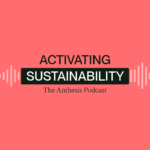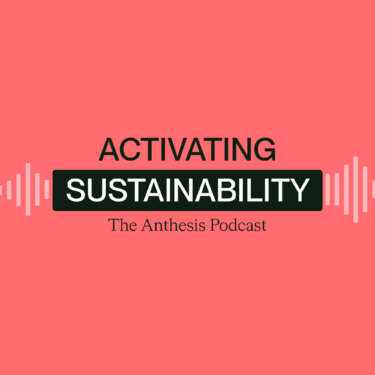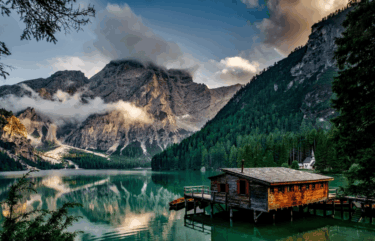
Speakers
Chris Peterson, Director
John Leppers, Director
Ella Baz, Senior Analyst
Related Topics
Share this episode
In this Activating Sustainability episode, our host Chris Peterson is joined by John Leppers, Director of Climate Neutral Group, and Ella Baz, Senior Analyst at Anthesis Group, to discuss a hot topic in the climate strategy and Net Zero world: carbon offsets.

Read the transcript
Chris: Hello and welcome to Activating Sustainability, the Anthesis Podcast. I’m your host, Chris Peterson. We hope that you’re all doing well today. We’re digging into the world of carbon offsets and how they should and can fit into a Net Zero climate strategy. To dig into this, I’m really pleased to be joined by members of the Anthesis Net Zero team, formally the Climate Neutral Group: John Leppers, Director and Ella Baz, Consultant. Right, well, Ella and John, welcome to the podcast. Thanks so much for joining.
John: Pleasure to be here, Chris.
Ella: Yeah, thanks for having us.
Chris: Great. Well, I know it’s been six plus months since the Climate Neutral Group joined Anthesis. I wonder if maybe just to start things off, you could just give us some insight about what made the Climate Neutral Group exist and kind of what are your approaches to offsets?
John: The Climate Neutral Group is already in existence for the last 20 years, so we’ve uh, we’ve been around in the climate domain when maybe not everybody had it as much as a priority as fortunately the world is having it today.
The reason why the company was established was really to address the emerging climate crisis, and particularly the emissions, to curb them onto a more healthy pathway. And what we do is very much along the line of logic.
First, you need to know what your emissions are. Then you need to have a plan to reduce them and an ambition and a way to get there. And for any remaining emissions, you can take accountability by buying offsets – that is investing in others that are already able to reduce or sequester carbon. And then if you’ve done all of that, we also carry a climate neutral certified certification program, which is third party verified that as a company you’ve gone through all that, which is also giving companies, but also the world looking at those companies, the assurance that it’s not only them that are saying it, but it’s also independently verified.
That’s sort of why the Climate Neutral Group came into existence and what we do, and we’re very excited to join Anthesis for the reasons of access to many more markets, many more clients. And in the combination we felt we made a much stronger partnership than what we’re able to do ourselves.
Chris: That was great. And I know Ella, you’re speaking to clients all the time. What do you hear from clients in terms of what they’re looking for from offsets?
Ella: We do a lot of work on, uh, kind of Net Zero with a lot of our clients, and offsetting very often comes into the conversation as a part of that work.
Very often clients don’t have a great understanding of the whole carbon markets and the voluntary carbon market, and we help them understand that and we get some insights from them as to what their perspective is and what their challenges are. And then speak to deep specialists like John and our colleagues at Climate Neutral Group.
Yeah, and very often there’s many things that they say. One of the first things is a lot of confusion around all the different terms and Net Zero and carbon neutrality and reductions and all that. We usually start with just a bunch of workshops as to, you know, what, what is this? What is carbon offsetting? What are the carbon markets and, and how would it fit in your sustainability strategy?
Chris: Great. Yeah, and maybe just picking up on that point around kind of what are carbon offsets, because it feels like those have been in the news, they’re somewhat controversial, et cetera. But know from speaking to the two of you, you know, there’s a real spectrum of what makes for a quality offset versus maybe something that isn’t as credible. I’m curious if maybe you could unpack that a little bit in terms of what that looks.
John: Not wanting to turn this into a history lesson, but sort of the carbon offsets have been around for a very long time and it came out of a idea that, let’s call it the Global North, had emissions. And the Global South had a capability to run programs to limit emissions, reduce, or sequester carbon.
That was the origin of the idea, and it was really a climate finance activity. But in addition, it was also the emitters taking accountability for the fact that they were having the emissions. And also the economic growth that causes those emissions, and they had the money to also then pay for a carbon offset program to be run.
That has changed and morphed into what is now the carbon offset market. In more general, a recognition that you’ve got parties who are emitting, they’re reducing what they can, but because of either economic or financial reasons, they’re not able to reduce to zero immediately, and therefore they take accountability by for the remaining emissions, they’re looking to generate offsets.
That’s sort of demand side of offsets. Then of course you also need to have a supply side, and that is where do you then find project(s) that are able to reduce or sequester carbon, and are they able to do that, and can you verify that? And this market didn’t come around sort of yesterday.
It’s been around. Over 20 years in which the standards have improved. And unfortunately, as any new market that’s developed, standards have to evolve. And so early on it might have been at lesser standards than what are applied today. And a lot of the misunderstandings of the carbon offset market are also from the early days rather than from what they are today.
So what’s an offset? On what criteria does it need to conform? There’s actually a body that’s called ICROA, the International Carbon Reduction and Offset Alliance, that’s been around for 10 to 15 years, and they’ve also set up rules: What does a carbon offset need to do?
There’s six things it needs to do. It needs to be real. Yeah, so the reduction or sequestration has to be real. It’s not sort of a figment of imagination.
It needs to be measurable. So you need to understand and be able to articulate where it came from.
It needs to be permanent. Yeah, So it’s not something that happens today and may be lost tomorrow, but you need to show permanence.
It needs to be additional. So without the financing from a carbon offset, the project or the reduction is not economically feasible or not possible at all.
It needs to be independently verified. It’s not somebody that says, “I’ve done something great, just trust me”. No, you need to go through a rigorous process to get that verified, and it needs to be unique. You can only count it once and you can’t keep counting it as you go along.
And if a credit conforms to these six rules, there is a minimum standard that they conform to. What you see is those rules are actually embodied by global registries, so there’s governance around it, and two well known are, for example, Gold Standard and Vera.
They are currently two of the largest global registries. They issue rules and they also have taken the guidance as to what an offset needs to do, needs to be able to do. And that gives credibility to the buyers that if you buy an offset from those programs, that they’ve gone through that rigorous process, and that what you’re buying is indeed real and is really a quality offset.
Chris: Right. Well, maybe just to help bring that into some of a little bit more tangible for myself and the listeners, are there examples of offset projects that really stand out to each of you as like, “Oh, I love this. Like this really exemplifies what we’re aspiring to do or achieve around that”.
John: Yeah, there are.
So when you talk about offsets, they often get grouped into different technologies that are generating the offset. So what’s been around for a while are a class that’s called renewable energy, and particularly if you take, for example, a least developed country, they don’t have access to finance, or it might be impossible because it’s not a securitized market to run, for example, a solar project.
So, they would like to move away from more fossil fuel, electricity, or energy generation into solar, but there’s simply no market. And then lots of people will say the developed world, “but you know what? Solar’s cheap enough, it needs to be able to pay for itself”, but they forget they do that against a regulated energy market where there’s feeding tariff.
Where you can have insurance, where you can have lots of the things that we call normal, which are simply not available in a least developed country. And then carbon offsets are a way to finance renewable energy programs. And that’s, for example, one thing that makes us very enthusiastic because it allows people to also get access to better living conditions by having electricity, which they often do not have today, while doing it in a way that is sustainable.
So, although the technology itself is economic, there simply isn’t a framework. I mean, people just don’t wanna put in their money because they think it’s too risky. And carbon offset findings is a means to finance those projects.
Other examples are methane capture from landfills. Again, if you live in the developed world, landfills are often a regulated business. They’re nicely covered. Any excess sort of methane that flows from a landfill gets captured, gets turned into renewable energy. There’s lots of legislation around it.
In many parts of the world, that’s simply not the case. And methane is a much more potent greenhouse gas than CO2. And if you’re able to capture that and turn it into renewable energy, it’s just a great way.
And it’s also, I mean, if you think about landfills, it’s just a waste of our affluent way of, of living. And if you’re able to capture the methane coming from it, which is derived from organic matter, it’s just a great way of doing that. And then the questions again, “but why aren’t governments regulating that? Why aren’t landfill operators investing?”
Because the infrastructure isn’t there. The money isn’t there. It’s simply not happening unless there’s carbon financing going into those projects.
And then I think the third, and then I’ll stop because you can see, I can get enthusiastic about this topic. Is reforestation, right? It’s either aforestation or reforestation.
There’s many parts in the world where forests are under threat for a variety of reasons, and being able to support the reforestation or aforestation of areas and it can also fight de-certification. That’s also a, a very well known technique that’s able to generate carbon offsets.
Chris: Great, yeah. And Ella, do you have a favorite that you can point to?
Ella: Yeah, I think another one that’s been around for a while and is pretty popular are the cook stove projects in Central Africa, where they distribute more efficient cook stoves for families to cook with. And the benefits of that is reducing deforestation for wood for families to cook with, and it has a lot of kind of extra socioeconomic benefits and also other biodiversity benefits as well, including better air quality, hygiene, pollution, and cooking environments.
John: Let me build on the cook stove projects because you’re highlighting correctly the respiratory issues. Yeah. Because again, what happens a lot is that the cooking actually takes place indoors in relatively small huts, poorly ventilated, and that leads to a lot of respiratory issues, both with women as well as girls who have the majority of tasks of, uh, providing food for their families.
It’s an interesting way to look at carbon offsets in a slightly different way because the way we provide priority to the greenhouse gas emissions. Yeah? Because climate is the primary element of carbon offset, but it also allows you to address a lot of other sustainable development goals.
And the cook stoves is a story, which also is something that’s close to my heart because who actually collects the wood? It tends to be the women and small girls. And because of the deforestation rates, they have to go further and further afield and might actually be spending six to eight to 10 hours a day just to collect the firewood. The other thing, which is not well known and difficult to talk to, but physical dangers are very real in many of those countries.
So for girls to be about and women to be about for that amount of time to collect firewoods, they often meet with bodily violence and it’s quite real. And if you hear those stories, all of a sudden a cook stove offset takes on a very different connotation. Then I’m doing something good for the world actually, there’s lots of benefits that come.
The other thing is that girls can’t go to school because they are not in their location enough. So if you’re going into a cook stove projects, which sort of starts with a more efficient way, that gives you less carbon emissions from the process of cooking, all of a sudden the raft of additional benefits are really staggering.
And that’s why we have supported from a Climate Neutral Group perspective, cook stove projects. For indeed those 20 years, we were one of the pioneers into supporting cook stove projects. So it’s something that’s close to my heart. Interestingly enough, you see clients are somehow less into cook stoves these days. They like renewable energy and forestry more because they can understand it more.
But for those that are willing to go beyond and look at other SDGs that they’re able to support, it’s certainly a technology which has lots of benefits that they can work into their SDG programs themselves as well.
Chris: That was great. Yeah, really interesting to think about both those co-benefits for kind of the offset providers, but then also for the customers, that sense of those additional benefits as well.
And you know, it’s interesting, I mean, it’s so exciting to hear about these stories. I’d say the cook stove is close to my heart as well, having spent my time around parafin cook stoves. But often we hear a lot of criticisms around offsetts. So most recently, a number of people probably have seen the John Oliver Last Week Tonight segment on this.
And I’d love to hear a little bit how you think organizations should prepare for that, or steps they can take to mitigate those criticisms or set themselves up to respond to them as they go forward?
Ella: Yeah, as I was saying before, there is just a lot of confusion around some of these terms, and I think some of that video, for example, was a bit misleading.
I think importantly, this space has evolved a lot over the last several years, and so has everyone’s understanding and big corporation’s understanding around offsets. So we have a lot of clients that are in more consumer facing industries who have consumer products or services, and they used to see carbon neutrality as almost a requirement because their peers were carbon neutral and they wanted to send that message to their customers.
And what that meant was just offsetting the lifecycle emissions of their products or of their service every year. And now they’re kind of almost pulling away from that to go a bit further in their thinking. They realize that Net Zero is different, and they’re kind of going through that thought process and understanding the value of offsets going forward.
I mean, also the other way around. So we’ve seen clients that we’ve been working for a long time with, uh, that were completely against offsets and now turning around thinking, “we need to do everything that we can do”. Started heavily investing in carbon projects and so yeah, there’s quite a lot to navigate in order to do it right.
The number one thing that John was saying is internal reductions, so reductions in your value chain need to be a priority. They need to come first. Then transparency around what their strategy is, their sustainability strategy. And specifying that they’ve done their carbon footprint, they’ve looked at what their footprint might look like in the future.
They’ve done a complete footprint, also importantly, and they have a strategy on how they’re gonna reduce that. And then third is just being really clear on the message that organizations are trying to send. So it’s not just about being carbon neutral, but it’s about showing that they’re actually doing a lot more than that.
They’re implementing production activities in their own operations, and then while doing that, they’re also contributing or supporting emission reduction projects, or avoidance projects elsewhere in the world.
Chris: John, anything you would add to that?
John: Yeah, so when you think about an offset, I think where some of the confusion came from, but I think a lot is being clarified now through lots of initiative, is that an offset is not a right to emit. And I think that’s where lots of people ease their minds or are misunderstanding. Believe, “if I buy an offset, I buy a right to admit. So if I buy more offsets, I can emit more”, but that’s not what the world needs.
I mean, it’s pretty clear that that’s not a way that will help us. Now you first need to reduce and you need to look at yourself and you need to see, whether you can present emissions or reduce them. And only then, you offset the remaining emissions because at this moment in time you can’t do it because of physical, technical, financial reasons, it makes no sense to reduce further at this particular moment in time. You need to make time to make the investments to come down further. And that’s different because this is about the voluntary market. You’ve also got mandatory markets in which the government sets a cap on emissions and then either hands over those rights to others, or you can buy the rights to offset.
But that’s a different market. That’s where you have a right to emit that has an economic value, and you can buy those if you are a large polluter and part of the scheme. Yeah? But in this case it’s not. It’s voluntary. So first you have to prevent or reduce emissions, and I think that’s important.
But when does a corporate get into trouble, and what are the areas where you need to be on the watch out?
One is, if your reductions, ambitions, and results you’ve achieved are not credible. So if you’re on a pathway to emit more and more and you want to use offset somehow, it’s tricky. You first need to have an ambitious path downwards in your emissions.
The second is if your claim is to positive or not realistic, and to highlight some that have come on the scrutiny, which is, if you fly and you buy for a relatively low amount, offsets to compensate your flight, It’s somehow okay to fly and fly even more, buy more offsets and it’s perfect. No, it’s not. Flying itself is not good for the environment and therefore, you should look at reducing it first. So be clearable about what an offset actually does, and don’t marketing claim it into absurdity, is what I would suggest.
The third is the quality of offsets. Offsets do range in quality. And in a growth market, we currently see in the voluntary carbon market. Lots of schemes are coming about that are promising you lots of things. Buy a tree and offset your family’s emissions for the rest of your life. Nobody checks whether the tree ever comes into existence or what happens with the tree thereafter.
They can be empty promises into the futures, but those are also the schemes currently being offered. So be very clear about the quality of offsets you’re buying. Are they coming from global registries? What is the project trying to achieve? And do they actually comply to the six elements mentioned before for quality offsets?
And then the third is if you’re making any claims, are they independently verified? If you are doing your own greenhouse gas accounting that nobody looks at and you’re claiming reductions and offsets that nobody actually has verified, then it gets tricky. So make sure that you do load yourself with some independent verification.
I’m not saying audits are always great and fun. But in a world of uncertainty, you do have to go through that in order to give credibility to the plans you have and the offsets that you’re using. And if you don’t fall into these four traps or do the four things that I’ve highlighted, then indeed I think corporates can very positively use offsets as part of their instruments that they’re using to play their role when it comes to porting on climate action.
Chris: Great. Yeah. I mean, fascinating discussion and given kind of all this, both the like positive contributions this can make, the signpost to be aware of in terms of having incredible pieces in place, kind of what would you recommend organizations do, how should they be thinking about or taking steps forward around offsets?
Ella: So, yeah, I mean the clients that we work with, a lot of them follow this Net Zero guidance. The Net Zero guidance, so that was published by the Science-Based Targets Initiative, gives a clear framework around how to set a Net Zero target, and the focus is very much on reductions, as it should be. But then, once the red reductions have been met in several years, then the company could invest in removals projects to sort of neutralize those residual emissions.
The Science-Based Target initiative also strongly recommends what they call beyond value chain mitigation, meaning throughout the target period, supporting avoidance projects or reduction projects, or even removals projects between their base year and their target year. So a lot of the companies that we’ve been engaging with, they wanna invest in projects, but they wanna invest in projects that are very close to them.
The type of the project is close to their own activities and their own operations, so they mean something to them, but they also want projects that are close geographically. Often they wanna plant trees, that comes up a lot and there’s nothing wrong with that, but it won’t deliver climate benefits for a while, if they start investing in planting trees, whereas putting that money towards, well, the cook stove projects, for example, you’d get a much bigger bang for your buck.
And there are so many areas for the very high potential for reduction in a lot of developing countries where they don’t have clean electricity, they don’t have clean ways of cooking, there’s lot deforestation going on, but all they really need is the finance to go towards making that happen.
So yeah, maybe clients should think about doing both. You know, in 2040 or 2045, they will have to invest in removals projects, but right now we also need to invest in the other types of projects.
The other thing I wanted to say is that many corporates just aren’t very comfortable with the idea of buying offsets because of this, because they see a lot of risks and a lot of criticism going around, and they don’t really know how to do it well, and a lot of them almost think that maybe it’s easier to just not get involved and not even purchase carbon credits.
But yeah, another way of thinking about it is it’s better to spend that money on these types of projects than just have no impact at all.
Chris: Just to unpack that last piece a little bit, ’cause I think that you’re hitting right on the challenge, right? Is why go into this voluntary space, right? It’s not required.
There’s risks associated with it, you know, there’s clearly a climate benefit, there’s potential additional benefits tied into that. But you know, as you think about organizations and trying to make that case internally, assuming that we’re talking about credible offsets, done in the parameters and the framework you’ve provided: What’s the why? What’s the benefit for organizations in taking that step?
John: It’s a fascinating question. So some organizations don’t even ask themselves that question. For them, It’s a moral thing that’s, “I emit, for some reason or another the world hasn’t regulated that, but I want to take accountability,” and we even see organizations now that are calculating their lifetime emissions and want to offset it because they don’t want to leave a footprint in the world when it comes to CO2 emissions.
Yeah. So if you talk to them, they go, like, “What a dark question!” Which is sort of, they are the converter. They are the ones that have taken action beyond what lots of others do. Then you’ve got people who say, “I wanna do what’s right for the world. I wanna do it for us.” And then it becomes an internal conversation to say, “if I’ve got waste water for which I need to pay in order it to be sent somewhere else for good treatment, I wanna do the same with my emissions. So, I wanna do it for myself.”
You’ve also got corporates that say, “I wanna get marketing value from it. I would like the world to show that we’re doing well, that we’re investing something, and that we’re ahead of the rest of the world, and I would like to get marketing value for that.” That can be a reason why corporates start, and as I already was highlighting, if you go the marketing way, make sure that you follow the robust steps already iterated yeah. That you do it properly and not just as a, as an easy way to a quick win because that no longer works.
Then you’ve also got corporates who say, “I don’t want to just buy offsets. I want to invest even more. I want to have a closer relationship to the project.”
It’s our experience that the wish is very strong, but you run into issues quite quickly, which is: long term investment, direct project exposure, or country exposure that they might not be as familiar; not having enough in-house knowledge to really judge the quality of a project and to continue also as further investments are required.
So, we often see that the conversation starts, “I wanna invest in something by myself”, but very often it ends up in, “I’d like to support somebody else’s project because I now understand that I’m not a project developer of an African project.” And so that’s something which is true, but I do understand and recognize the questions coming up often, but when you go into detail, it often doesn’t match their risk profile or their investment profile the corporates are looking for.
You’ve got some larger clients who have seen this as strategic, so they say the climate challenge is for us, a strategic driver, and we are going to turn this into a business. That’s where you see often whole teams are being brought into the organization. Budgets are made available. They might be early venture funding going on in new technologies, or they might establish their own project organization.
But we often see that to be really valid for the really large corporates that are willing to go down that road (There’s some good examples out there of parties that do that), but often for me, it’s never a gold standard because the reason why they can do it, because they’ve got the financial capability and the internal capability to do so. For most corporates, that will be certainly a bridge, if not two bridges too far and the better – we would suggest you join an existing program already.
Chris: Great. Yeah, and I know we’re coming up on time, but I’d be remiss not to hit on a couple of topics that I’m sure are top of mind for listeners and myself. One would be, we talked a little bit about planting trees and the desire to plant trees, and I think that’s the ubiquitous model lots of people have in their head.
But I also know, John, you kind of called out permanence as a key element of that. I’m curious kind of how that’s managed, particularly in that case, When you think about forest fires or the instability of forest, et cetera around that. Do you have any kind of thoughts or guidance for how people should be thinking about that?
John: If you run a forestry project, for which you would like to have carbon offsets, you first need to sort of calculate a baseline. Yeah, sort of what would happen without the intervention. And then as trees grows into the biomass above ground and below ground, that’s sort of where you start to store carbon.
A project only issues exposed, yeah? So something needs to have happened before a carbon credits get issued. So the tree has already grown. ‘Cause otherwise you will be able to get a carbon offset. That’s important. So there’s many programs out there that says the tree will grow, but a carbon offset according to the global standards, the tree has grown.
Yeah? So it’s called exposed. It’s already an event that has happened.
Okay. Then the project itself needs to contain a buffer. Yeah? So you’re not able to get all of the carbon that you store out. You need to maintain a buffer, and every global project that is in the forest needs to have that buffer in their own project.
Then the registry maintains a global buffer. So you also need to add to that because what the registry says is you as a buyer buy a forestry credit, you need to have the guarantee that that carbon is indeed there and stays there. All right. Now, unfortunately, the project you bought, there is a forest fire, and that, of course has a lot of carbon or CO2 released into the air.
So what happens, then? You, if you’ve bought the credit, you are guaranteed first by the buffer in the project itself and then by the global buffer. So if you go into the Amazon buyers, which I think if I’m correct or that we’re raging a lot last year, if you take it from a global offset program perspective, the Amazon that disappeared into the fires, if you take that, was less, far less, than what is actually in the global buffer.
So there is a robustness in the system that if it’s in between brackets, your tree that burned down, there’s the system that keeps it whole. And it’s almost similar – you can call a banking system where there’s a guarantee system that if your money gets lost somehow, yeah? The banks all amongst themselves guarantee that your money is still there.
That’s also true of the global offset market. That’s another reason why we would always recommend to go with large global registries, cuz if we go with a local offset scheme that’s trying to do its thing, then often these types of events are simply not covered because there’s not enough mask that goes into a global buffer that can sustain that.
So this is, it’s got a bit technical, but these are assurances that are brought in to the schemes that if you buy an offset as a corporate, there’s a guarantee and a method behind providing that guarantee that at offset is real and permanent. It might not be the the actual tree, but the system keeps you whole.
Chris: That’s great. That I think helps clarify things a lot for myself and, and hopefully others. The last one maybe just quickly is, I know there’s a lot of discussion about removals versus avoidance. I’m wondering if, maybe, one of you could speak to that, quickly?
Ella: Avoidance per projects and emission reduction projects are projects that avoid emissions from happening that would’ve otherwise happened.
So they have a program and they implement this program or this activity, and it kind of changes the way things would’ve been otherwise. So we’re distributing cook stoves. We’re avoiding wood being burned for cooking. Or we’re working on a forest conservation project, we’re conserving a forest from being a deforested for other purposes.
And right now there are a lot of avoided emissions projects out there, a lot of credits that are from these kinds of projects. The hope is that in several years there just won’t be any more of these ’cause it will will be kind of regulation or we’ll have subsidies for clean energy everywhere and there will be less and less of these projects.
And then removals are when you plant a tree and carbon is sequestered from the atmosphere and stored, or if we have carbon capture and sequestration technology technologies, for example. And yeah, the idea is that over time we’ll have more and more of those.
Chris: Right. And it sounds like both can be done in a very credible way if it’s done purposefully, right?
Like, maybe not just the, like, we’re gonna go up and plant a tree, but we’re going to purposefully approach this and something that fits with the ICROA approach.
John: The way that we look upon it is that the world needs and, and, and, yeah? So it’s very nice how the world is sometimes pitted against one another.
Are you for avoidance? Or against avoidance? Or for removals? Or against removals?
And the one thing we know is we need everything. So if we first take down the Amazon, there’s no way we’ll be able to plant enough trees elsewhere in order to rectify that. Yeah? So we need to and save the sort of forest that are already out there and we need to grow more forest, if you take that sort of lens.
Whether you want to be using avoidance credits or removal credits, depends on both your budget. What do you want to achieve? How does it fit with your corporate strategy? And that normally leads clients to choose one over the other. Yeah, so there’s a variety of reasons why they choose one over another.
There’s another thing, particularly around avoidance, and there is a conversation going on. Shouldn’t governments secure forests already? Yeah, so why is it going through the voluntary carbon market to finance the activities to safeguard forest? And to be honest, I don’t know. I would love governments to step up and save all of the forest and guard them and do what we all hope them to do, but they’re not.
So – I think it’s realism talking here – is that without the financing, through the voluntary carbon markets, there will be less efforts to safeguard our forest. Should it be through the voluntary carbon markets? Oh gosh, I, we can debate this philosophically. I would love other mechanisms to be way, way better than the voluntary carbon market, but because those activities aren’t there yet, or those measures aren’t there, it works pretty well.
Yeah, there’s some very good programs out there on conservation, uh, items. If you, as a corporate, again, whether you want to use that or not, we can debate, but that’s a little bit how we look upon it. Both are. And the voluntary carbon market is offering a good climate finance for conservation projects.
Chris: Wonderful. And I know we’re, we’re up on time, so maybe just kind of final thoughts on any kind of advice, guidance, et cetera. Maybe Ella, do you wanna kick that off?
Ella: Yeah. Number one for me is to be very, very transparent and very clear with a company’s strategy.
What is your story? So what are you, what are you doing? What initiatives have you started internally? And then if you wanna support carbon projects, then which ones are they? Just put a, you know, add a link to the actual project so that people can go and look at it. And then what exactly are you buying them four? Or is it to cover your emissions? Is it just to contribute?
So yeah, I think, I think just transparency around the whole process.
Chris: Great. And John final thoughts?
John: Yeah, I would very much agree with, uh, what Ella says. Be transparent about what it is that you do. The other thing that we’ve learned is don’t let perfect get in the way of good enough.
And is everything clear? Can you do it without risk? Won’t somebody else think something about it? Yes, of course. But for us, taking accountability of your remaining emissions after you’ve reduced to what you can is something that we would always encourage, and there is a way to deal with it well, and therefore, we believe it’s an additional tool that is required because we do need everybody to do what they can to give ourselves a fighting chance of curbing the impact of climate change.
That’s why offsets, they’re not perfect. We will never claim that, but they’re good enough. They do what it says on the tin. They either reduce or sequester carbon, and we need corporates to, or those programs, in addition to reducing their own emissions.
Chris: Great. Well, thank you both so much. Really appreciate the chance to connect and you helping to shed some light on this really fascinating part of the solution. So thank you very much.
John: Pleasure. Thanks for having us!
Chris: And thank you all for joining. You can find links to the resources and case studies we discussed in today’s podcast in the show notes.
And can reach John, Ella, or myself at [email protected]. Thanks again and take care.
Inside this episode
- What carbon offsets are and how they fit within your wider sustainability efforts.
- The origin of carbon offsets and how the carbon market has evolved and improved.
- How to vet and verify carbon offsets according to industry-accepted standards.
- Examples of standout carbon offset projects around the world.
- How offset credibility has evolved and how organisations can respond to criticisms of carbon offsets.
If you have any feedback on the podcast, get in touch with our host Chris Peterson at: [email protected]















